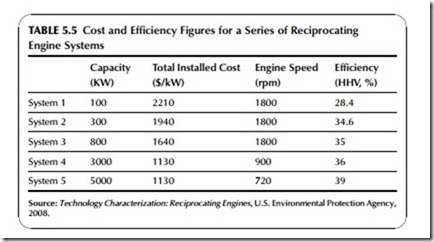COST OF RECIPROCATING ENGINE-BASED POWER GENERATION
The economics of power generation based on reciprocating engines depends to a large extent on the use to which the engine is to be put. The cheapest engines available are small petrol-driven engines based on car engines, which are manufactured in large numbers each year. These engines can be purchased as stand- by generators for as little as $250/kW. Such engines are cheap so they are well suited to applications where they will only be required to operate infrequently. However, they are expensive to run since their energy conversion efficiency is relatively low and they have short lifetimes, requiring the extensive and regular maintenance of an automotive engine.
Large engines designed for power generation are generally much more expensive. Natural gas–fired engines of around 300 kW are likely to cost around $2000/kW. While detailed cost data tends to be proprietary, evidence suggests that capital costs drop as engine size rises into the megawatt and multi-megawatt range. All these larger engines are built to be able to operate for long periods between maintenance. They are generally more efficient than the smaller engines too, so their operating costs are lower.
Table 5.5 shows figures for a range of generic power generation systems based on reciprocating engines that illustrates these trends. The costs in this
table are in year 2010 U.S. dollars. The smallest system in the table, with a generating capacity of 100 kW, is based on a high-speed engine operating at 1800 rpm. Efficiency is 28.4% and the cost is $2210/kW. At the other end of the scale a 5 MW system is based on a medium-speed engine running at 720 rpm. This has an efficiency of 39% and an installed cost of $1130/kW.
The cost effectiveness of most systems such as those in Table 5.5 will depend on whether they can be used to supply heat as well as electrical power. All the systems in the table were assessed for their cogeneration efficiency when providing hot water. The most efficient were systems 2 and 3 with overall efficiencies of 78% and 79%, respectively. The least efficient was system 4 at 73%.
The cost of Stirling engines is much higher than for most internal combustion engines because they are not produced in large enough quantities to bring about the economy of volume production. Estimates vary widely, from as low as $2000/kW to as high as $50,000/kW.
